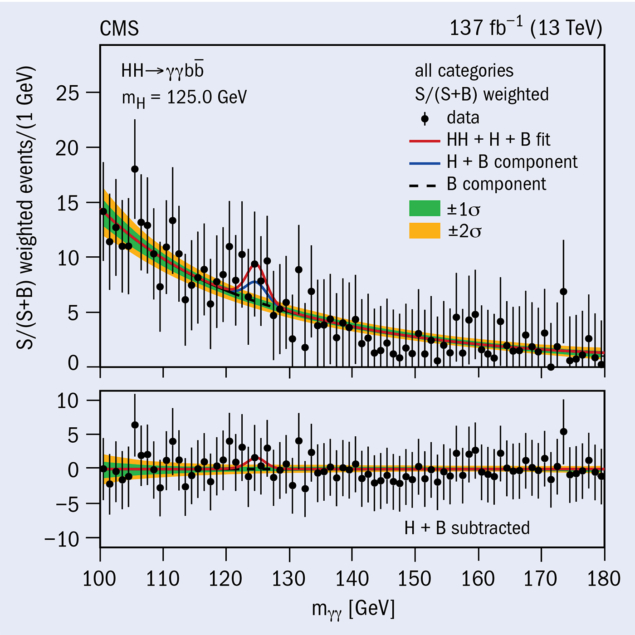A report from the CMS experiment

The Higgs boson discovered in 2012 by the ATLAS and CMS experiments is the pinnacle of the scientific results so far at the LHC. Measurements of its couplings to W and Z bosons and to heavy fermions have provided a strong indication that the mechanism of electroweak symmetry breaking is similar to that proposed by Brout, Englert and Higgs (BEH) more than 50 years ago. In this model, the BEH field exists throughout space with a non-zero field strength corresponding to the minimum of the BEH potential. The measurement of the shape of the BEH potential has become one of the main goals of experimental particle physics. It governs not only the nature of the electroweak phase transition in the early universe, when the BEH field gained its non-zero “vacuum expectation value” (VEV), but also the question of whether deeper minima than the present vacuum exist.
The measurement of the production of Higgs-boson pairs gives a direct way to measure λ
Interactions with the BEH VEV give mass not only to the W and Z bosons and the fermions, but also to the Higgs boson itself. If the mass of the Higgs boson is well known, the Standard Model (SM) can therefore predict the Higgs self-coupling, λ – the key unknown parameter in the shape of the BEH potential of the SM. The measurement of the production of Higgs-boson pairs (HH) gives a direct way to measure λ. Higgs-boson pair production is not yet established experimentally, as it is a thousand times less frequent than the production of a single Higgs boson. However, the presence of physics beyond the SM can substantially enhance the HH production rate. The search for HH production at the LHC is therefore an important test of the SM.
Best constraint
A recent result by the CMS collaboration describes a search for HH production in final states with two photons and two b-jets (figure 1). The large data sample collected during LHC Run 2 excludes a HH production rate larger than 7.7 times that predicted by the SM. CMS has set the best constraint to date on the ratio of the measured λ parameter to the SM prediction, κλ = 0.6+6.3–1.8.
The sensitivity of the analysis has been improved by about a factor four over the previous result that used the data collected in 2016, benefitting equally from the increase in luminosity and from a wealth of innovative analysis techniques. The electromagnetic calorimeter of the CMS experiment allows the measurement of H → γγ candidates with excellent resolution (about 1–2%). Advanced machine-learning techniques, including deep neural networks, were introduced to significantly improve the mass resolution of H → bb, from 15% down to 11%. The analysis combines information from the invariant mass of the HH system, reflecting the underlying physics processes, and a multivariate classifier exploring the kinematic properties as well as the identification of photons and b-jets.
Events were categorised to enhance the sensitivity to Higgs production via gluon fusion as well as, for the first time, vector-boson fusion. The latter constrains the quartic coupling between two vector bosons and two Higgs bosons, such as WWHH, which is an extremely rare interaction in the SM. In addition, dedicated categories from a previous analysis were added to account for the associated production of top quarks and a single Higgs boson, and to provide a simultaneous constraint on the top-quark Yukawa coupling and λ. Several hypotheses predicting new physics were also constrained. The results are an encouraging step forwards in the quest to measure the BEH potential and to further interrogate the SM.
Further reading
CMS Collab. 2020 arXiv:2011.12373.






